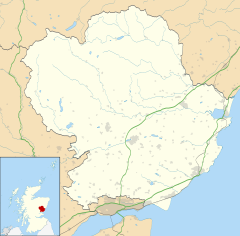Eassie
| Eassie | |
|---|---|
 Eassie Eassie shown within Angus | |
| OS grid reference | NO353474 |
| Council area |
|
| Lieutenancy area |
|
| Country | Scotland |
| Sovereign state | United Kingdom |
| Post town | FORFAR |
| Postcode district | DD8 |
| Dialling code | 01307 |
| Police | Scottish |
| Fire | Scottish |
| Ambulance | Scottish |
| EU Parliament | Scotland |
| UK Parliament |
|
| Scottish Parliament |
|

Rear view of Eassie Primary School
Eassie is a village located along the A94 road in Angus, Scotland.[1] The church in Eassie is dedicated to Saint Fergus, a monk who worked at nearby Glamis.[2] Eassie is noted for the presence of the Eassie Stone, a carved Pictish stone.[3]
Other notable prehistorical or historical features in this region include Dunnottar Castle, Fasque House, Glamis Castle, Monboddo House, Muchalls Castle, Raedykes, Stone of Morphie and Stracathro.
Famous residents
Prof James Miller (1812–1864) was born in the manse in Eassie and raised in the village.
See also
- List of places in Angus
- Ark Hill
- Castleton
- Drumtochty Forest
References
| Wikimedia Commons has media related to Eassie. |
^ "Dundee and Montrose, Forfar and Arbroath", Ordnance Survey Landranger Map (B2 ed.), 2007, ISBN 0-319-22980-7.mw-parser-output cite.citation{font-style:inherit}.mw-parser-output q{quotes:"""""""'""'"}.mw-parser-output code.cs1-code{color:inherit;background:inherit;border:inherit;padding:inherit}.mw-parser-output .cs1-lock-free a{background:url("//upload.wikimedia.org/wikipedia/commons/thumb/6/65/Lock-green.svg/9px-Lock-green.svg.png")no-repeat;background-position:right .1em center}.mw-parser-output .cs1-lock-limited a,.mw-parser-output .cs1-lock-registration a{background:url("//upload.wikimedia.org/wikipedia/commons/thumb/d/d6/Lock-gray-alt-2.svg/9px-Lock-gray-alt-2.svg.png")no-repeat;background-position:right .1em center}.mw-parser-output .cs1-lock-subscription a{background:url("//upload.wikimedia.org/wikipedia/commons/thumb/a/aa/Lock-red-alt-2.svg/9px-Lock-red-alt-2.svg.png")no-repeat;background-position:right .1em center}.mw-parser-output .cs1-subscription,.mw-parser-output .cs1-registration{color:#555}.mw-parser-output .cs1-subscription span,.mw-parser-output .cs1-registration span{border-bottom:1px dotted;cursor:help}.mw-parser-output .cs1-hidden-error{display:none;font-size:100%}.mw-parser-output .cs1-visible-error{font-size:100%}.mw-parser-output .cs1-subscription,.mw-parser-output .cs1-registration,.mw-parser-output .cs1-format{font-size:95%}.mw-parser-output .cs1-kern-left,.mw-parser-output .cs1-kern-wl-left{padding-left:0.2em}.mw-parser-output .cs1-kern-right,.mw-parser-output .cs1-kern-wl-right{padding-right:0.2em}
^ Elizabeth Rees, Celtic Sites and their Saints (2003) Continuum Publishing
ISBN 0-86012-318-9
^ C.Michael Hogan, Eassie Stone, The Megalithic Portal, ed. Andy Burnham, 7 Oct. 2007
This Angus location article is a stub. You can help Wikipedia by expanding it. |